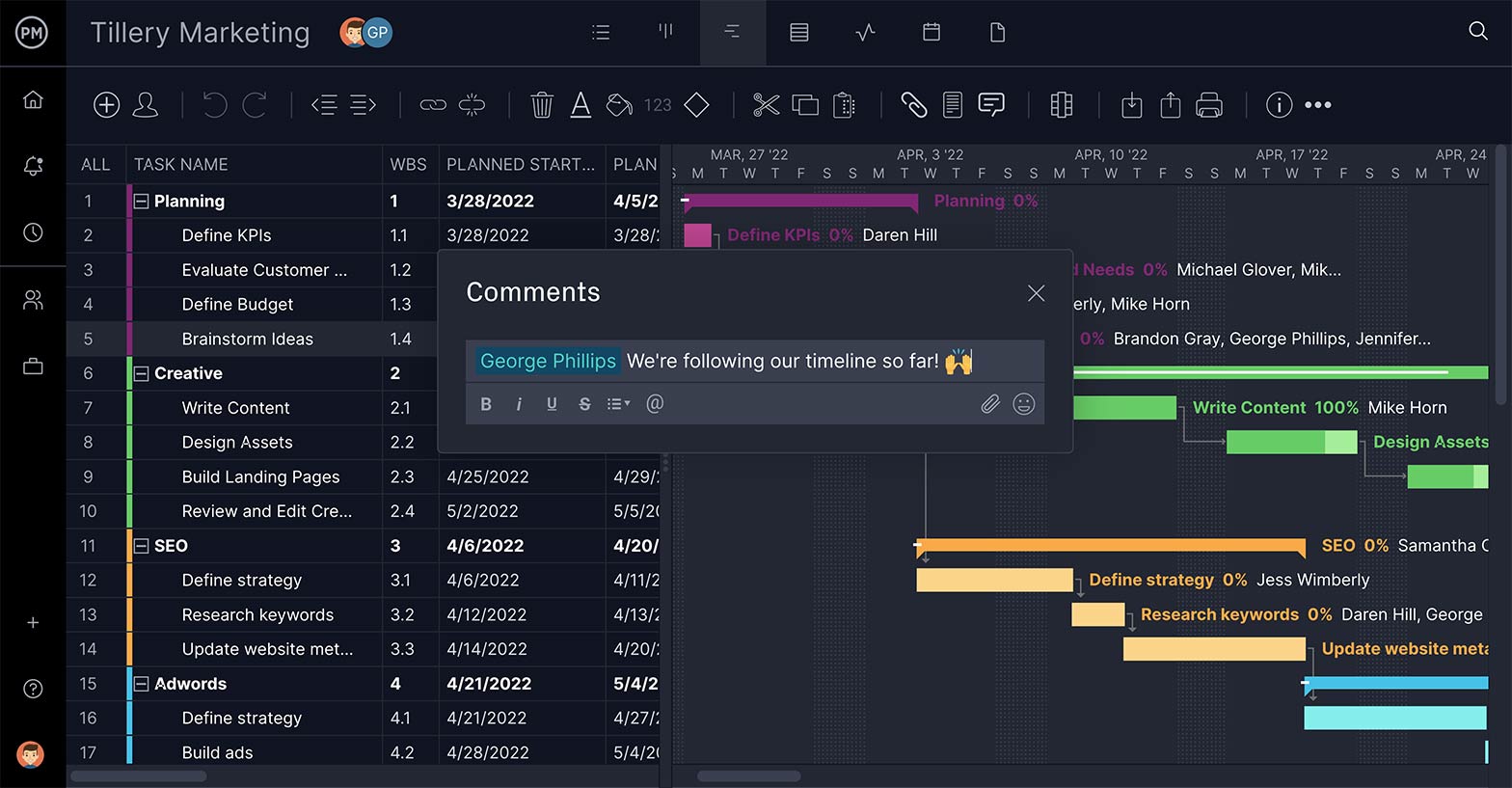We say it all the time — change is inevitable. This adage is as true for projects and organizations as it is for everything else. Change can feel like an inconvenience or a response to unexpected trouble. And while this does happen, a change request can also be completely natural, and even positive, in the grand scheme of things. Because, ultimately, change is evolution.
So, how can changes be used to your advantage in project management? We create a system to guide these changes. This system prevents confusion and disorganization which can sink and operate, and it all begins with a change request.
What Is a Change Request?
Change requests act as these formal documents and are a core component of a change management plan. These documents outline modifications to some aspect of the project or organization — usually at a high level, such as a project deliverable or organizational operations.
The requests for change can come from within or outside the organization, and while requested changes can vary wildly, the process for creating them is the same. This continuity simplifies the process of creating, submitting, monitoring and approving (or denying) them.
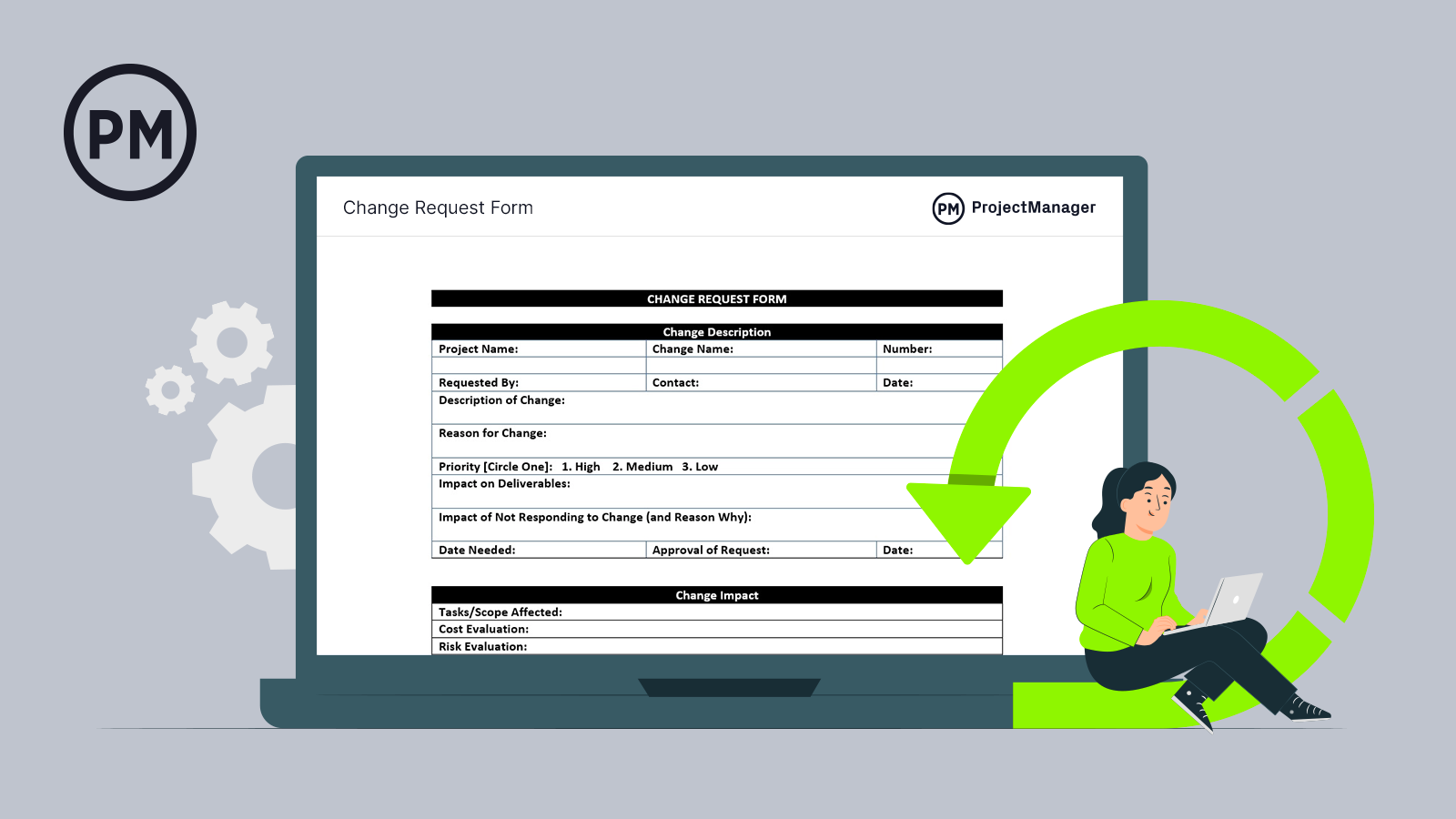

Get your free
Change Request Form
Use this free Change Request Template for Word to manage your projects better.
What Is the Purpose of a Change Form?
In any project or organization, there is the potential that processes or tasks will need to be changed. Change requests exist to officially document details about those aspects that need to be altered. Their purpose is to request a modification and control this change.
These modifications can be necessary when high-level goals and objectives and/or project deliverables change or are added on to. For example, a client may want to change the deliverables of a project, a company may want to expand its mission, an organization may want to improve communication or internal operations. The list goes on. Regardless of what the change is, change requests document the proposed modification.
These formal requests list all pertinent information and are then passed along to an individual stakeholder (or a board or comity of individuals) for approval. Change requests summarize everything they need to know and simplify how the change management process will progress.
Project management software makes it easier to manage change for your projects and wider organization. With ProjectManager, incorporate change into your project schedules with robust Gantt charts with dependencies, baseline tracking and version control. Leverage built-in risk management features and collaborate on tasks online with your team in List or Board views. It’s software designed specifically with project management in mind. Try ProjectManager today for free.
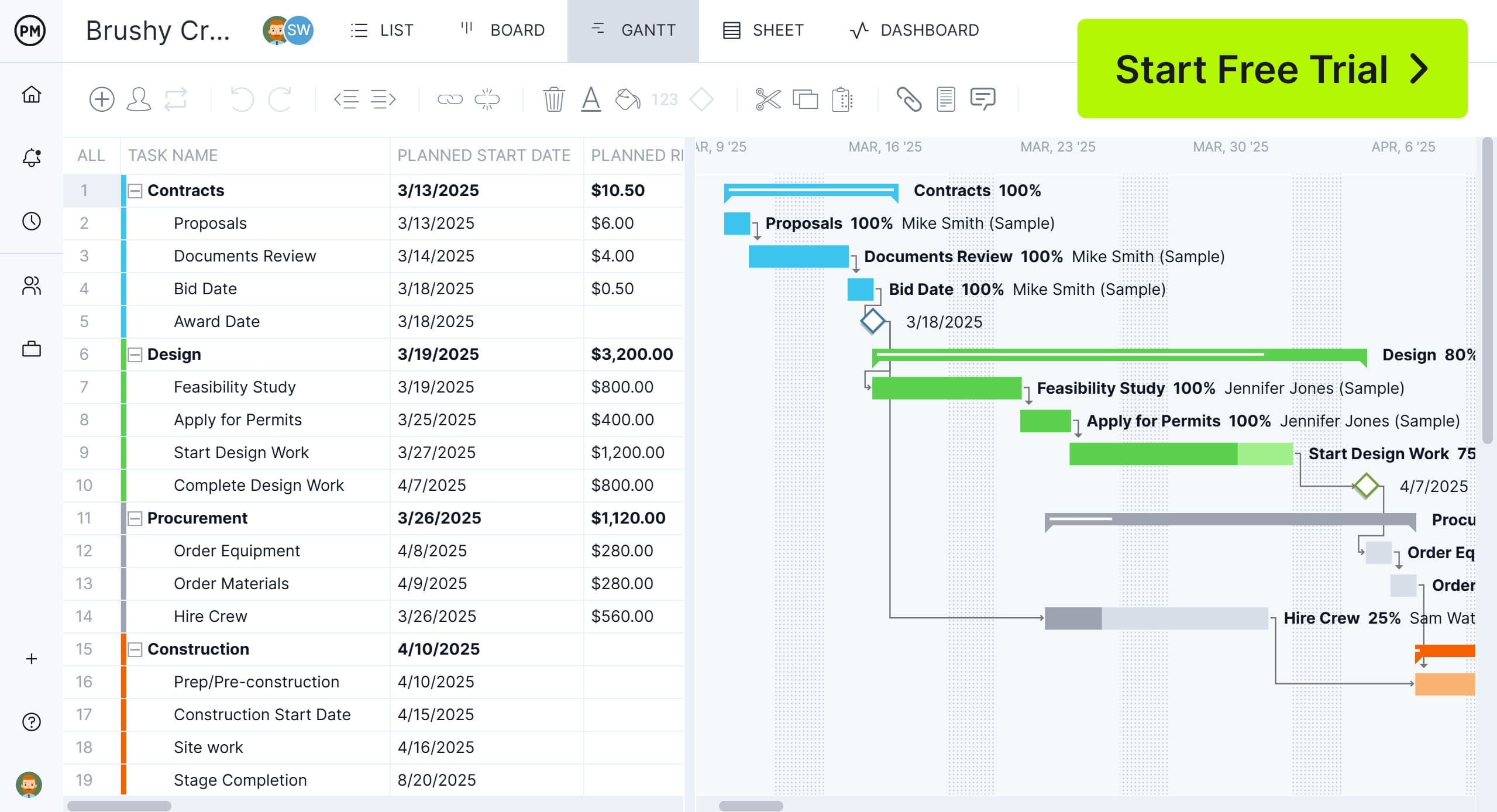

What Should Be Included in a Change Request Form?
No matter the kind of request for change is made, there are a few bases you should be sure to cover. Start with these core components and build out the rest of your change requests around them.
- Request Title: A brief, descriptive title that summarizes the nature of the change being requested.
- Request Number / ID: A unique identifier assigned to the change request for tracking and reference.
- Date of Request: The date on which the change request is formally submitted.
- Requestor Information: The name, role and contact details of the person initiating the change request.
- Description of Change: A detailed explanation of the proposed change, including what is being changed and why.
- Reason for Change: A justification for the change, explaining the problem, opportunity or requirement prompting it.
- Impact Analysis: An evaluation of how the change will affect the project’s scope, schedule, budget, resources and quality.
- Resource Requirements: A summary of additional personnel, tools, time or budget needed to implement the change.
- Potential Risks: Any known risks or uncertainties that could arise as a result of implementing the change.
- Proposed Solution or Alternative: The recommended approach to implement the change, including any alternative options.
- Affected Documents/Deliverables: A list of project documents, components or deliverables that will be impacted by the change.
- Priority Level: The urgency or importance of the change, typically categorized as low, medium or high.
- Approval Section: A space for reviewers or decision-makers to record their names, roles and signatures as part of the approval process.
- Decision: The final determination (e.g., approved, rejected, deferred) regarding the change request.
- Implementation Plan: A high-level plan describing how the change will be executed, including steps, timeline and responsibilities.
- Comments: An optional section for additional notes, clarifications, or supporting information related to the change.
Depending on the type of change or the organization or project, you may wish to include additional details. This is completely fine, but you’ll want to keep these additional sections short and sweet and be sure the format of each request is as consistent as possible.
Change Request Form Example
To better understand what a change request is, here is an example. The section below outlines the essential details of the change request, including who submitted it, when and what the change entails. In the example, the request is to add e-commerce functionality to a website redesign project, with a high priority due to shifting business goals.
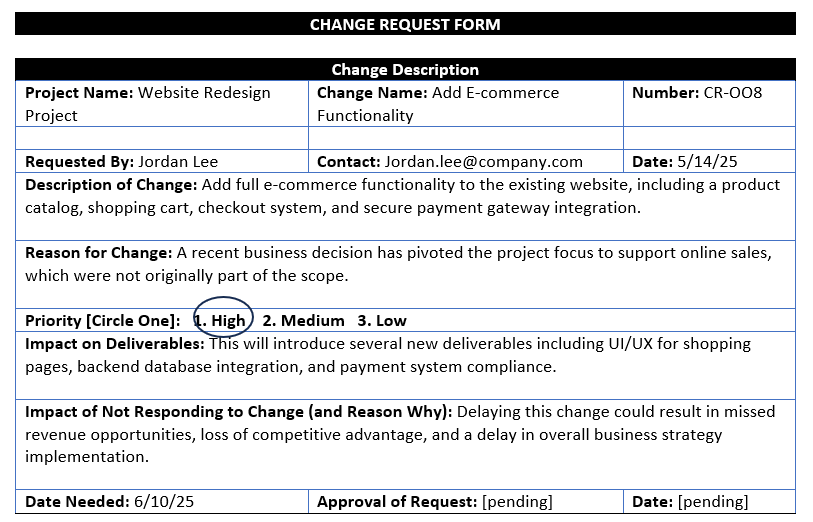

Here, the broader implications of the change are evaluated, such as the effect on project scope, budget, resources, risks and schedule. The proposed change adds complexity, requires additional staff and time, and shifts the deadline by several weeks—factors critical to project planning.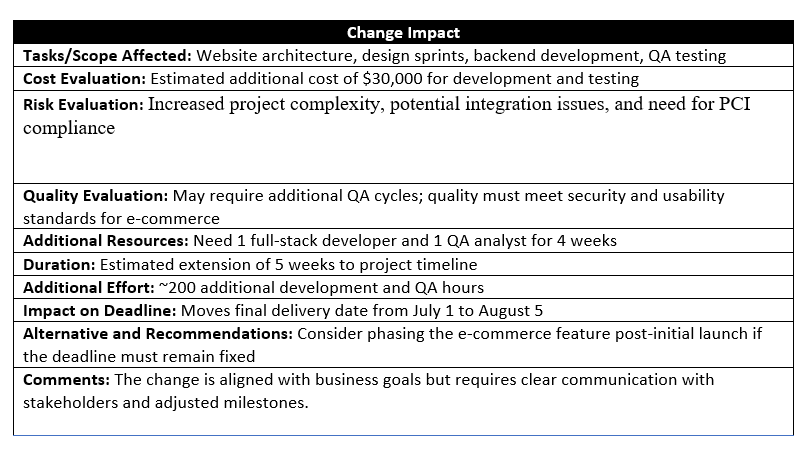

The final section captures the official decision regarding the change, with space for comments and approval signatures. In the example, the change is accepted with a note on privacy considerations and the necessary stakeholders sign off to authorize implementation.


Change Request Form Template
Get started making change requests at your organization with this template. Our free change request form template for Word will help you describe the change, evaluate the impact of the change, establish a sign-off process and more. It’s the ideal way to integrate change management into your projects and business. Download yours today.
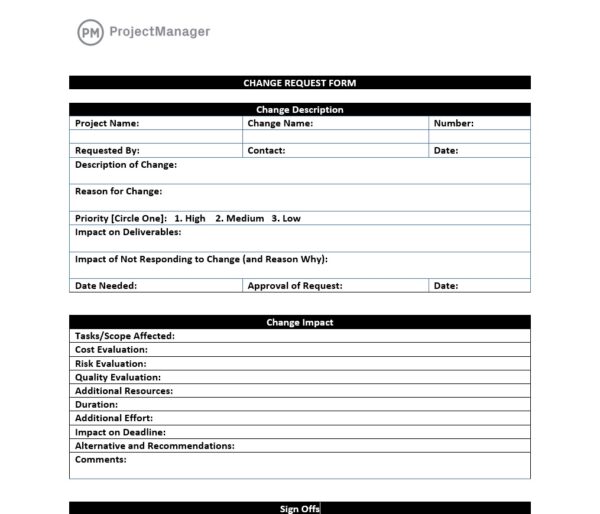

What Is Change Request Management?
Change request management is the structured process of identifying, evaluating and implementing changes within a project or organization. It ensures that any proposed modifications—whether to scope, schedule, budget, resources or deliverables—are carefully reviewed and approved before execution. The goal is to maintain project control and alignment with objectives while minimizing disruptions and risks.
This process typically involves submitting a formal change request, conducting impact assessments, involving key stakeholders and documenting decisions. Change request management is essential in dynamic project environments where new information, shifting priorities, or unforeseen issues can necessitate adjustments. By following a standardized approach, teams can make informed decisions, ensure transparency and maintain accountability throughout the project lifecycle.
Free Related Change Management Templates
The change request form is only one of over 100 free project management templates for Excel and Word that cover all aspects of managing projects across multiple industries. Here are just a few that relate to change management.
Change Management Plan Template
Download this free change management plan template for Word to guide organizations through the process of managing change effectively. It outlines how changes—whether organizational, technical, procedural or strategic—will be identified, assessed, approved, implemented and monitored. This template provides a standardized format to ensure consistency, clarity and alignment across all change initiatives.
Change Impact Assessment Template
Use this free change impact assessment template for Excel to evaluate how a proposed change will affect various aspects of a project, process, organization or system. It helps decision-makers understand the scope and implications of a change before implementation, enabling better planning, risk mitigation and communication with stakeholders.
Change Log Template
This free change log template for Excel is used to track and manage changes throughout the lifecycle of a project. It provides a centralized record of all requested, approved, deferred or rejected changes, including essential details like the nature of the change, when it was made, who initiated it and its impact on project scope, schedule and cost.
Types of Change Requests
Change requests can be sorted into different categories, depending on the objective of the change. Here are the four key types of change requests to be aware of. Each of these four can apply to both projects and organizations as a whole.
- Normal Change: A normal change request addresses a significant alteration to operations, existing systems, infrastructure, etc. This type isn’t uncommon, but it does imply substantial, far-reaching changes need to be made. And, as you can imagine, normal change requests often result in additional ones.
- Standard Change: A standard change request proposes a low-risk change that occurs often. As we’ve discussed, many changes are perfectly natural over the course of a project or in an organization. These changes can be thought of as evolution. They are proposals outlining what needs to be modified, but the modification itself will follow a preexisting system.
- Major Change: A major change request proposes a significant change that will require substantial financing. Major changes pose a high risk, but they can also reap high rewards. These changes don’t occur often, and if they’re handled poorly, they can do serious damage. That being said, they’re necessary to make extreme modifications.
- Emergency Change: An emergency change request is a high-priority proposal for immediate change. This type is generally the result of a mistake or something not going as planned and can be used to prevent these unexpected circumstances from wreaking havoc.
How to Establish a Change Request Process
It’s important to have a concrete system of processing requests in place. This creates a set of steps anyone can follow and cuts down on errors. This will look different depending on the industry, organization or project, but there are some universal points they need to hit. Here are a few to focus on:
1. Create a Change Request Form for Your Organization
Change requests can impact many aspects of a project plan or even the entire organization. But, no matter what kind of requests are submitted, they should all contain the same components and answer the same questions. For this reason it is highly advisable to use a change request form for any change requests that might be required throughout the organization. This consistency in formatting makes for better records and more thorough reporting.
Because consistency is so important, many organizations choose to use templates when creating one. These templates make it simple to find the information you’re looking for because you’re already familiar with the formatting. A template also ensures no details are left out.
2. Assemble a Change Control Board
Assembling a Change Control Board (CCB) involves selecting a group of stakeholders who are responsible for reviewing, evaluating, approving or rejecting change requests in a structured and consistent way. A well-formed CCB ensures that proposed changes align with project goals, stakeholder interests and organizational priorities.
Typically, the change control board includes the following.
- Project Manager: Chairs the board, facilitates discussions and ensures the change process aligns with project goals and timelines.
- Project Sponsor or Executive Stakeholder: Provides strategic oversight and ensures changes align with business objectives and funding constraints.
- Product Owner or Client Representative: Represents the end-user perspective and assesses how changes impact functionality, value and usability.
- Functional Leads or Department Heads: Offer input on how proposed changes affect operations, staffing and departmental responsibilities.
- Quality Assurance Lead: Evaluates changes for their impact on deliverable quality, testing protocols and compliance.
- Risk Manager: Analyzes potential risks introduced by the change and recommends mitigation strategies.
- Technical Lead or Systems Architect: Assesses feasibility, resource implications and technical impact of the proposed change.
- Change Manager (if applicable): Oversees the change process and ensures adherence to organizational change management frameworks.
3. Establish a Chain of Communication Between Requestors and the Change Control Board
Submitting a request to the change control board is not the end of the process. In fact, submitting often only starts a longer conversation. Regardless of whether a change request is approved or denied, there will likely be some back and forth between the person submitting the request and the person responsible for reviewing it.
Because change requests do often start these conversations, it’s important to establish exactly how these “edits” will be discussed or questions will be asked. Each party must know who to speak to and how to voice their questions, concerns, criticism, etc. When there is a set communication plan in place, this cuts down on conflict and improves efficiency.
4. Create a Change Log to Register Change Requests
This step involves documenting all submitted change requests in a centralized change log. The change log acts as an official record that tracks each request from submission through resolution. It captures key details such as the request ID, date submitted, description, requestor name, status, priority and decision outcome.
Maintaining a change log ensures transparency, accountability, and traceability throughout the change management process. It helps project managers and stakeholders monitor progress, avoid duplication and evaluate the overall impact of changes on scope, budget, timeline and resources. An up-to-date change log is essential for successful project governance and communication.
5. Assess the Potential Impact of Change Requests
Before approving a change request, it’s essential to evaluate how the proposed change will affect various aspects of the project. A structured impact assessment helps project teams make informed decisions, avoid unintended consequences and maintain alignment with project goals. Below are the core areas to assess.
- Scope: Determine whether the change expands or reduces the project’s deliverables or objectives. Will new tasks be added? Are existing requirements being modified?
- Schedule: Evaluate how the change will affect the timeline. Will it delay milestones or the final delivery date? Does it compress time for other tasks?
- Cost: Assess the financial implications. Will additional funding be needed? Are there potential cost savings or increases?
- Quality: Consider how the change may impact the quality of deliverables. Will it compromise standards, or does it aim to improve outcomes?
- Resources: Analyze whether the change requires more personnel, equipment, or materials. Is current capacity sufficient, or are additional resources needed?
- Risks: Identify new risks introduced by the change and determine how they affect the project’s overall risk profile. Are mitigation strategies required?
6. Approve, Deny or Defer the Change Request
When evaluating a change request, there are typically three decisions a change control board (CCB) or project decision-makers can make.
- Approve: If the change request aligns with project goals, provides value and has acceptable impacts on scope, schedule, cost and resources, it should be approved. Approval indicates that the change will be implemented according to the proposed plan and reflected in updated project documentation.
- Deny: A change request is denied if it introduces unacceptable risks, costs or misalignment with project objectives. This decision halts further consideration unless the request is revised and resubmitted.
- Defer: Deferring a change request means postponing the decision. This often happens when more information is needed or when the project isn’t at the right phase to accommodate the change.
7. Implement the Change Request
When approved, it’s time to execute the resulting changes. This usually falls to many different individuals and can even involve different departments. Perhaps the most important part of establishing a change management process is deciding what will happen after a request is approved.
Although the changes being approved can vary widely, the steps after approval should look the same. This includes holding a meeting and completing necessary forms such as a change order. The key is having a system in place to take approved requests from documents and turn them into reality.
8. Conduct a Post-Implementation Review After Executing Change Request
A post-implementation review (PIR) after executing a change request assesses whether the change met its objectives, its impact on the project and lessons learned. For instance, in a project where a new user feedback feature was integrated into a website, the PIR evaluates whether the feature improved user engagement and provided valuable insights. Feedback from stakeholders, including product owners and support teams, confirmed the success of the change.
The review also looks at the impact across various areas like scope, schedule, cost, quality, resources and risk, all of which were successfully managed. Key lessons learned include the importance of early stakeholder input and the smooth collaboration between teams. Recommendations for the future might include continued monitoring of user engagement trends and exploring additional interactive features for the site. This review ensures that the change request was not only successfully executed but also provides valuable insights for continuous improvement.
How ProjectManager Helps Manage Changes in Your Project
When creating and submitting change requests, it’s important to have the proper documentation tools. Throughout the course of a project, you will need to organize and store an array of documents so that everything is easy for anyone to find and nothing is lost. ProjectManager allows you to upload all the documents you need to your project, with unlimited file space.
And if you need to point out a specific detail on a change request, simply leave a comment in the document and tag the team member(s) you want to show. This eliminates the need to email PDFs. back and forth and puts all your correspondences in one space.
Keeping all of your change requests in one location also makes it easy to execute the changes themselves. Because these requests live in the same space as your project plan, schedule, dashboard, task management tools and more, you can make adjustments with only a few clicks and get to work immediately.
Related Change Management Content
ProjectManager is a cloud-based software that manages changes to your project with features that guide you through every step. Identify what needs to change, plan the change and then track its progress all with the same tool. Assume total control of project changes by trying ProjectManager for free today.



